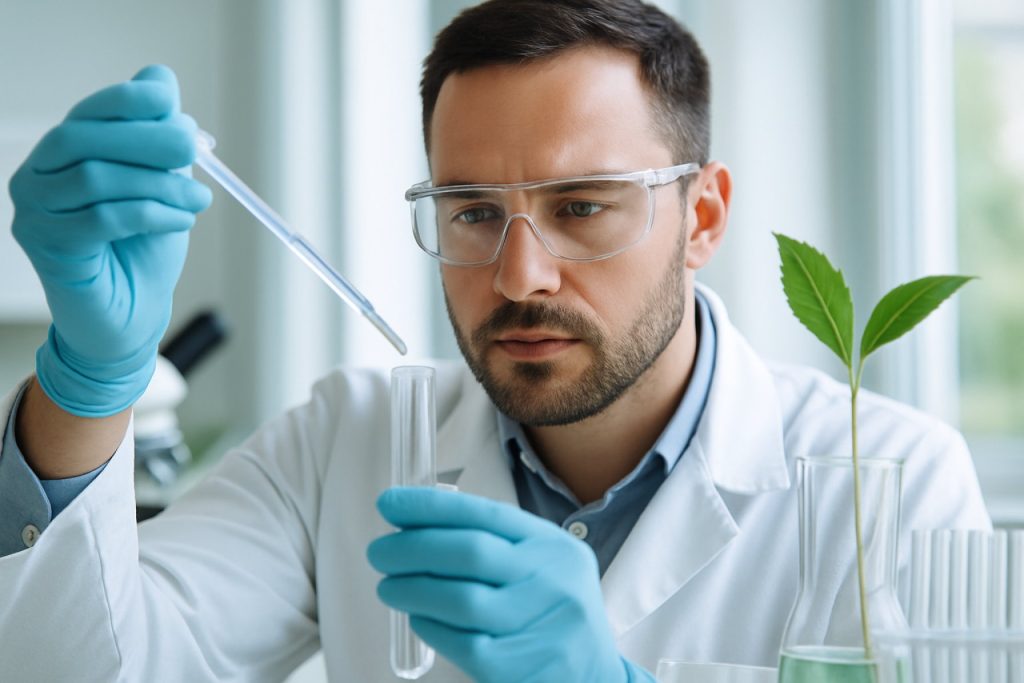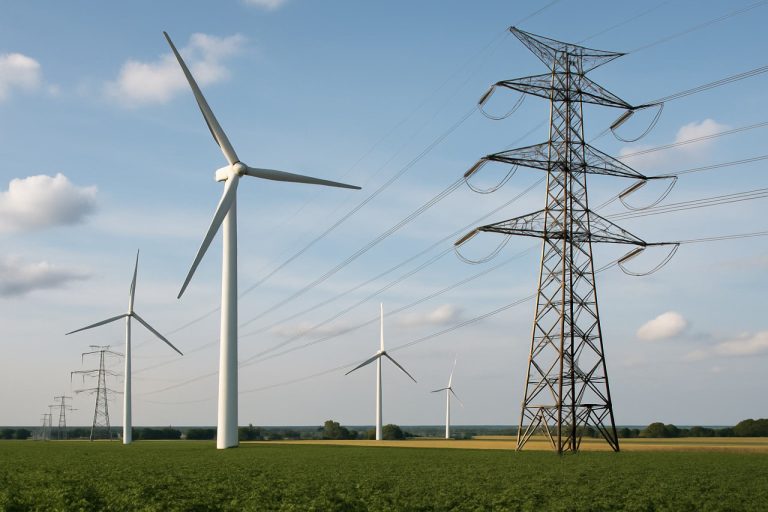
Enzyme-Catalyzed Polymer Synthesis in 2025: Accelerating Sustainable Materials and Transforming Polymer Manufacturing. Explore the Breakthroughs, Market Growth, and Future Impact of Enzyme-Driven Polymerization.
- Executive Summary: Key Trends and Market Drivers in 2025
- Market Size, Segmentation, and 2025–2030 Growth Forecasts
- Technological Advances in Enzyme Engineering and Polymerization
- Sustainability and Environmental Impact: Green Chemistry in Focus
- Competitive Landscape: Leading Companies and Strategic Initiatives
- Emerging Applications: Bioplastics, Medical Devices, and Beyond
- Regulatory Environment and Industry Standards
- Challenges: Scale-Up, Cost, and Enzyme Stability
- Investment, Partnerships, and M&A Activity
- Future Outlook: Innovation Roadmap and Market Opportunities Through 2030
- Sources & References
Executive Summary: Key Trends and Market Drivers in 2025
Enzyme-catalyzed polymer synthesis is emerging as a transformative approach in the polymer industry, driven by the demand for sustainable, energy-efficient, and environmentally benign manufacturing processes. As of 2025, the sector is witnessing accelerated adoption, propelled by advancements in enzyme engineering, increased regulatory pressure for green chemistry, and the growing market for biodegradable and bio-based polymers.
A key trend is the integration of advanced biocatalysts—such as lipases, cutinases, and engineered hydrolases—into industrial polymerization processes. These enzymes enable the synthesis of polyesters, polyamides, and polycarbonates under mild conditions, reducing energy consumption and minimizing hazardous byproducts. Companies like Novozymes, a global leader in industrial biotechnology, are expanding their enzyme portfolios to target polymer applications, focusing on both performance and processability. Similarly, BASF is investing in enzyme-catalyzed routes for specialty polymers, leveraging its expertise in both enzyme development and polymer chemistry.
The market is also shaped by collaborations between chemical manufacturers and biotechnology firms. For instance, DuPont has been active in developing bio-based monomers and polymers using proprietary enzyme technologies, aiming to replace petrochemical feedstocks with renewable alternatives. These partnerships are expected to intensify in the coming years, as companies seek to scale up enzyme-catalyzed processes from pilot to commercial production.
Regulatory frameworks in the EU, North America, and Asia are increasingly favoring green manufacturing, with incentives for bio-based and biodegradable materials. This is accelerating the commercialization of enzyme-catalyzed polymers, particularly in packaging, textiles, and medical devices. The European Bioplastics Association reports a steady increase in the share of bio-based polymers in the global plastics market, with enzyme-catalyzed synthesis playing a pivotal role in this growth.
Looking ahead, the outlook for enzyme-catalyzed polymer synthesis is robust. Ongoing R&D is expected to yield more robust and selective enzymes, further lowering costs and expanding the range of accessible polymers. Major industry players such as DSM and Corbion are investing in next-generation biocatalysts and process intensification, aiming to capture a larger share of the sustainable polymers market. As consumer and regulatory pressures mount, enzyme-catalyzed synthesis is poised to become a mainstream technology in polymer manufacturing by the late 2020s.
Market Size, Segmentation, and 2025–2030 Growth Forecasts
The global market for enzyme-catalyzed polymer synthesis is poised for robust growth between 2025 and 2030, driven by increasing demand for sustainable materials, regulatory pressure to reduce environmental impact, and advances in enzyme engineering. Enzyme-catalyzed processes are gaining traction as alternatives to traditional chemical polymerization, offering milder reaction conditions, higher selectivity, and the potential for biodegradable end-products. The market encompasses a range of polymer types, including polyesters, polyamides, and polysaccharides, with applications spanning packaging, biomedical devices, textiles, and specialty chemicals.
Segmentation of the enzyme-catalyzed polymer synthesis market is typically based on polymer type, enzyme type, application, and geography. Polyesters—especially polylactic acid (PLA) and polycaprolactone (PCL)—represent the largest segment, owing to their established use in biodegradable packaging and medical applications. Lipases and cutinases are the most widely used enzymes, with ongoing research expanding the enzyme toolbox for new monomers and polymer architectures. Geographically, Europe and North America lead in adoption, supported by strong regulatory frameworks and the presence of major players, while Asia-Pacific is expected to witness the fastest growth due to expanding manufacturing capacity and increasing environmental awareness.
Key industry participants include Novozymes, a global leader in industrial enzymes, which has developed tailored biocatalysts for polymer synthesis and is actively collaborating with polymer manufacturers. BASF is another major player, investing in enzyme-enabled processes for specialty polymers and sustainable plastics. DuPont has also entered the space, leveraging its expertise in both enzymes and materials science to develop novel biopolymer solutions. These companies are joined by specialized firms such as Enzymicals AG, which focuses on custom enzyme development for polymer applications, and Amano Enzyme, a supplier of industrial enzymes for polymer and resin synthesis.
Recent data from industry sources and company reports indicate that the enzyme-catalyzed polymer synthesis market is expected to grow at a compound annual growth rate (CAGR) of 8–12% through 2030, with the market size projected to reach several billion USD by the end of the decade. Growth will be underpinned by increasing commercialization of enzyme-catalyzed processes, particularly in the production of biodegradable plastics and high-value specialty polymers. Strategic partnerships between enzyme producers and polymer manufacturers are anticipated to accelerate technology adoption and market expansion.
Looking ahead, the outlook for 2025–2030 is highly positive, with continued innovation in enzyme engineering, process optimization, and feedstock diversification. The sector is expected to benefit from policy support for green chemistry and circular economy initiatives, as well as growing consumer demand for sustainable products. As enzyme-catalyzed polymer synthesis moves from pilot to commercial scale, the market is set to play a pivotal role in the transformation of the global polymer industry.
Technological Advances in Enzyme Engineering and Polymerization
Enzyme-catalyzed polymer synthesis is rapidly advancing as a sustainable alternative to traditional chemical polymerization, with significant technological progress expected in 2025 and the following years. The field is driven by the need for greener processes, reduced energy consumption, and the ability to tailor polymer properties with high precision. Recent developments focus on engineering robust enzymes, expanding substrate scope, and scaling up biocatalytic processes for industrial relevance.
A key area of innovation is the engineering of hydrolases, such as lipases and cutinases, to catalyze polycondensation and ring-opening polymerization reactions under mild conditions. Companies like Novozymes and BASF are at the forefront, leveraging protein engineering and directed evolution to enhance enzyme stability, activity, and selectivity. For example, Novozymes has developed proprietary lipase variants capable of synthesizing polyesters and polyamides with controlled molecular weights and architectures, suitable for applications in packaging and biomedical materials.
In 2025, the integration of computational design and machine learning is expected to accelerate the discovery of novel enzyme catalysts. BASF and DSM are investing in digital platforms to predict enzyme-substrate interactions and optimize reaction conditions, reducing development timelines. These approaches enable the customization of enzymes for specific monomers, including bio-based and recycled feedstocks, aligning with circular economy goals.
Scale-up and process intensification are also critical trends. DuPont and Corbion are piloting continuous flow bioreactors and immobilized enzyme systems to improve productivity and reduce costs. Such systems facilitate the production of high-performance polymers like polylactic acid (PLA) and polybutylene succinate (PBS) with minimal by-products and lower environmental impact. Corbion, for instance, is expanding its PLA portfolio using enzyme-catalyzed processes to meet growing demand in packaging and medical sectors.
Looking ahead, the outlook for enzyme-catalyzed polymer synthesis is promising, with expectations of broader adoption in specialty and commodity polymer markets. The convergence of enzyme engineering, process automation, and sustainable feedstocks positions this technology as a cornerstone of the next-generation polymer industry. Ongoing collaborations between industrial leaders and academic institutions are likely to yield further breakthroughs, driving commercialization and supporting global sustainability targets.
Sustainability and Environmental Impact: Green Chemistry in Focus
Enzyme-catalyzed polymer synthesis is rapidly gaining traction as a cornerstone of green chemistry, offering a sustainable alternative to traditional petrochemical-based polymerization processes. As of 2025, the sector is witnessing significant advancements, driven by the dual imperatives of reducing environmental impact and meeting regulatory demands for greener manufacturing. Enzymatic processes, particularly those utilizing lipases and cutinases, enable polymerization under milder conditions—lower temperatures, atmospheric pressure, and aqueous or solvent-free systems—thereby minimizing energy consumption and hazardous byproducts.
Major chemical and biotechnology companies are actively scaling up enzyme-catalyzed polymerization. BASF, a global leader in chemicals, has invested in biocatalysis platforms to develop biodegradable polyesters and polyamides, emphasizing reduced carbon footprint and improved end-of-life options. Similarly, Novozymes, renowned for its industrial enzyme production, collaborates with polymer manufacturers to optimize enzyme formulations for specific monomer substrates, enhancing both yield and selectivity. These collaborations are crucial for commercializing bio-based polymers such as polylactic acid (PLA) and polyhydroxyalkanoates (PHA), which are increasingly used in packaging, textiles, and medical devices.
Recent data from industry consortia and trade organizations indicate a marked increase in the adoption of enzyme-catalyzed processes. The European Bioplastics association reports that, as of 2025, bioplastics production capacity is projected to surpass 3 million tonnes globally, with a growing share attributed to enzymatic synthesis routes. This shift is supported by regulatory frameworks in the EU and North America, which incentivize the use of renewable feedstocks and biodegradable materials.
Environmental impact assessments conducted by companies such as DuPont and Corbion demonstrate that enzyme-catalyzed polymerization can reduce greenhouse gas emissions by up to 50% compared to conventional methods, primarily due to lower energy requirements and the avoidance of toxic catalysts. Furthermore, the enzymatic approach facilitates the use of agricultural waste and non-food biomass, aligning with circular economy principles and reducing reliance on fossil resources.
Looking ahead, the outlook for enzyme-catalyzed polymer synthesis is robust. Ongoing research focuses on engineering more robust and substrate-specific enzymes, expanding the range of monomers and polymers accessible via biocatalysis. Industry leaders anticipate that, within the next few years, enzyme-catalyzed processes will become mainstream for specialty and high-performance polymers, further embedding sustainability into the heart of polymer manufacturing.
Competitive Landscape: Leading Companies and Strategic Initiatives
The competitive landscape for enzyme-catalyzed polymer synthesis in 2025 is characterized by a dynamic interplay between established chemical giants, specialized biotechnology firms, and innovative startups. This sector is witnessing accelerated activity as companies seek to leverage enzymatic processes for sustainable, high-performance polymers, driven by regulatory pressures and consumer demand for greener materials.
Among the global leaders, BASF SE continues to invest in biocatalysis platforms, integrating enzyme-catalyzed routes into its portfolio of polyesters and polyamides. BASF’s collaborations with academic institutions and technology providers have resulted in pilot-scale production of bio-based polymers, with ongoing efforts to scale up enzymatic synthesis for commercial applications. Similarly, DSM (now part of dsm-firmenich) has expanded its enzyme technology capabilities, focusing on specialty polymers for medical and packaging sectors, and is actively developing proprietary enzyme systems for tailored polymer architectures.
In the specialty enzyme domain, Novozymes stands out as a key supplier of industrial enzymes, including those tailored for polymerization processes. Novozymes has announced partnerships with polymer manufacturers to co-develop enzyme-catalyzed processes for biodegradable plastics and functionalized polyesters, aiming to reduce energy consumption and environmental impact. DuPont (now part of Corteva and IFF for different business units) continues to advance its enzyme engineering platforms, with a focus on high-efficiency catalysts for polycondensation and ring-opening polymerization, targeting both performance and sustainability.
Emerging players are also shaping the competitive landscape. Carbios, a French biotech, has gained attention for its proprietary enzymatic recycling and synthesis technologies, particularly for PET and PLA polymers. In 2024–2025, Carbios has expanded pilot operations and entered into joint development agreements with major packaging and textile companies to commercialize enzyme-enabled circular polymer solutions. Meanwhile, Amyris leverages synthetic biology to design custom enzymes for the synthesis of specialty polymers and monomers, with a focus on cosmetics and high-value materials.
Strategic initiatives across the sector include joint ventures, licensing agreements, and open innovation platforms. Companies are increasingly investing in R&D consortia and public-private partnerships to accelerate the commercialization of enzyme-catalyzed polymer synthesis. The outlook for the next few years points to intensified competition, with a focus on process scalability, cost reduction, and the development of novel polymer functionalities that meet both regulatory and market demands.
Emerging Applications: Bioplastics, Medical Devices, and Beyond
Enzyme-catalyzed polymer synthesis is rapidly advancing as a sustainable alternative to traditional chemical polymerization, with significant implications for bioplastics, medical devices, and other high-value applications. As of 2025, the field is witnessing a surge in both research activity and commercial interest, driven by the need for greener processes and the unique properties imparted by enzymatic catalysis.
In the bioplastics sector, enzyme-catalyzed synthesis is enabling the production of polyesters such as poly(lactic acid) (PLA) and polyhydroxyalkanoates (PHAs) under milder conditions and with greater selectivity than conventional methods. Companies like Novozymes, a global leader in industrial enzymes, are actively developing tailored lipases and cutinases for polymerization processes, aiming to improve yield and reduce environmental impact. Similarly, BASF is investing in enzyme technology to enhance the biodegradability and performance of their biopolymer product lines, with ongoing collaborations targeting scalable enzymatic routes for specialty plastics.
Medical device manufacturing is another area where enzyme-catalyzed polymer synthesis is making inroads. The precision and mild reaction conditions of enzymatic processes are particularly advantageous for synthesizing polymers used in drug delivery systems, tissue engineering scaffolds, and resorbable sutures. Evonik Industries, a major supplier of medical-grade polymers, is exploring enzymatic synthesis to create novel copolymers with tunable degradation rates and improved biocompatibility. These efforts are expected to yield new materials that meet stringent regulatory requirements while minimizing residual catalysts and byproducts.
Beyond bioplastics and medical devices, enzyme-catalyzed polymerization is being explored for advanced coatings, adhesives, and even electronics. The ability to design enzymes for specific monomer substrates is opening pathways to functional polymers with unique architectures. DuPont and DSM are among the companies investigating enzyme-enabled synthesis for specialty applications, leveraging their expertise in both biotechnology and materials science.
Looking ahead, the next few years are expected to bring further integration of enzyme engineering, process intensification, and digitalization to optimize enzyme-catalyzed polymer synthesis. Industry collaborations and public-private partnerships are likely to accelerate commercialization, especially as regulatory and consumer pressures for sustainable materials intensify. As enzyme costs decrease and process efficiencies improve, enzyme-catalyzed polymer synthesis is poised to become a mainstream technology across multiple sectors.
Regulatory Environment and Industry Standards
The regulatory environment for enzyme-catalyzed polymer synthesis is evolving rapidly as the technology matures and gains commercial traction. In 2025, regulatory agencies and industry bodies are increasingly focused on ensuring the safety, sustainability, and traceability of biocatalytic processes, particularly as they pertain to the production of polymers for medical, food-contact, and consumer applications.
The European Union remains at the forefront of regulatory development, with the European Medicines Agency (EMA) and the European Food Safety Authority (EFSA) providing guidance on the use of enzymes in the synthesis of polymers intended for pharmaceutical and food-contact materials. The EU’s REACH regulation continues to require detailed registration and risk assessment for new polymeric substances, including those produced via enzymatic routes. In 2025, the European Chemicals Agency (ECHA) is expected to further clarify the status of enzyme-catalyzed polymers under REACH, particularly regarding the classification of biobased and biodegradable polymers.
In the United States, the U.S. Food and Drug Administration (FDA) and the U.S. Environmental Protection Agency (EPA) are the primary regulators for enzyme-catalyzed polymers, especially for applications in medical devices, packaging, and environmental remediation. The FDA’s Center for Food Safety and Applied Nutrition (CFSAN) has updated its guidance on food-contact substances to include specific considerations for enzyme-derived polymers, emphasizing the need for comprehensive toxicological and migration data.
Industry standards are also being shaped by organizations such as the International Organization for Standardization (ISO) and the ASTM International. ISO’s Technical Committee 61 (Plastics) is actively developing new standards for biobased and enzyme-catalyzed polymers, focusing on terminology, testing methods, and sustainability criteria. ASTM has recently published protocols for the characterization and biodegradability assessment of enzyme-synthesized polymers, which are being adopted by manufacturers to demonstrate compliance and facilitate market access.
Major industry players, including BASF and Novozymes, are collaborating with regulatory bodies and standards organizations to ensure that enzyme-catalyzed polymer products meet evolving requirements. These companies are also investing in traceability systems and life cycle analysis to support claims of sustainability and regulatory compliance.
Looking ahead, the regulatory landscape is expected to become more harmonized globally, with increased emphasis on environmental impact, end-of-life options, and the circular economy. Stakeholders anticipate that clearer guidelines and robust standards will accelerate the adoption of enzyme-catalyzed polymer synthesis across diverse industries in the coming years.
Challenges: Scale-Up, Cost, and Enzyme Stability
Enzyme-catalyzed polymer synthesis has emerged as a promising alternative to traditional chemical polymerization, offering advantages such as mild reaction conditions, high selectivity, and reduced environmental impact. However, as the field moves into 2025 and beyond, several critical challenges remain in scaling up these processes for industrial application, particularly regarding cost efficiency and enzyme stability.
One of the primary hurdles is the scale-up of enzymatic polymerization from laboratory to industrial levels. While companies such as Novozymes and BASF have demonstrated the feasibility of enzyme use in specialty polymer production, the transition to large-scale manufacturing is hampered by the relatively high cost of enzymes compared to conventional catalysts. Enzyme production itself requires significant resources, and the purification steps necessary for high-performance applications further add to the expense. As of 2025, enzyme costs remain a limiting factor for widespread adoption in commodity polymer markets, though ongoing advances in fermentation technology and enzyme engineering are expected to gradually reduce these barriers.
Enzyme stability under industrial conditions is another significant challenge. Many enzymes, such as lipases and cutinases used in polyester and polyamide synthesis, are sensitive to temperature, pH, and the presence of organic solvents. This sensitivity can lead to rapid deactivation, reducing the overall efficiency and increasing operational costs due to frequent enzyme replacement. Companies like Novozymes are actively developing more robust enzyme variants through protein engineering and immobilization techniques, aiming to enhance operational stability and reusability. Immobilization, in particular, allows enzymes to be recovered and reused, which is crucial for cost-effective industrial processes.
Another aspect is the compatibility of enzymatic processes with existing industrial infrastructure. Most large-scale polymerization plants are designed for chemical catalysts and high-temperature operations, which are not optimal for enzymes. Retrofitting or redesigning reactors to accommodate enzymatic processes involves significant capital investment and technical risk. Industry leaders such as BASF and DSM are exploring hybrid processes and modular reactor designs to bridge this gap, but widespread implementation is still in its early stages.
Looking ahead, the outlook for enzyme-catalyzed polymer synthesis will depend on continued innovation in enzyme engineering, process integration, and cost reduction. Collaborative efforts between enzyme producers, polymer manufacturers, and equipment suppliers are expected to accelerate progress. If these challenges can be addressed, enzymatic polymerization could play a significant role in the sustainable production of advanced materials over the next decade.
Investment, Partnerships, and M&A Activity
The landscape of investment, partnerships, and M&A activity in enzyme-catalyzed polymer synthesis is rapidly evolving as the sector matures and sustainability imperatives drive innovation. In 2025, the field is witnessing a surge in strategic collaborations and capital inflows, particularly as major chemical and biotechnology companies seek to expand their portfolios with greener, bio-based polymer solutions.
A notable trend is the increasing involvement of established chemical giants in enzyme-enabled polymerization. BASF, for example, has continued to invest in biocatalysis platforms, leveraging enzyme technology to develop specialty polymers with reduced environmental footprints. The company’s ongoing partnerships with biotech firms and academic institutions are aimed at scaling up enzyme-catalyzed processes for commercial production of polyesters and polyamides.
Similarly, DSM has expanded its biopolymer division through targeted acquisitions and joint ventures, focusing on high-performance materials synthesized via enzymatic routes. DSM’s collaborations with enzyme specialists and polymer manufacturers are designed to accelerate the market introduction of novel, bio-based plastics for automotive, packaging, and consumer goods applications.
On the biotechnology front, Novozymes remains a key player, actively forming alliances with polymer producers to supply tailored enzyme solutions for polymer synthesis and recycling. The company’s recent investments in R&D and pilot-scale facilities underscore its commitment to advancing enzyme-catalyzed processes as a viable alternative to traditional petrochemical methods.
Startups and scale-ups are also attracting significant venture capital and corporate backing. Companies such as Carbios have secured funding rounds and strategic partnerships with global brands to commercialize enzymatic depolymerization and repolymerization technologies, particularly for PET recycling and upcycling. These collaborations are expected to accelerate the deployment of enzyme-based solutions at industrial scale over the next few years.
Looking ahead, the sector is poised for further consolidation as larger players seek to acquire innovative startups and proprietary enzyme platforms. The growing emphasis on circular economy models and regulatory pressures to reduce plastic waste are likely to fuel additional M&A activity and cross-sector partnerships. As enzyme-catalyzed polymer synthesis moves from pilot to commercial scale, investment is expected to flow into infrastructure, process optimization, and supply chain integration, positioning the field for robust growth through 2025 and beyond.
Future Outlook: Innovation Roadmap and Market Opportunities Through 2030
Enzyme-catalyzed polymer synthesis is poised for significant growth and innovation through 2030, driven by increasing demand for sustainable materials and advances in enzyme engineering. As of 2025, the sector is witnessing a convergence of biotechnology and polymer chemistry, with several industry leaders and startups investing in scalable, green manufacturing processes. The use of enzymes—such as lipases, cutinases, and esterases—enables the synthesis of polyesters, polyamides, and other specialty polymers under mild conditions, reducing energy consumption and minimizing hazardous byproducts.
Major chemical and biotechnology companies are actively developing enzyme-catalyzed routes for both commodity and specialty polymers. BASF has publicly committed to expanding its biopolymer portfolio, leveraging enzymatic processes to produce biodegradable plastics and intermediates. Similarly, Novozymes, a global leader in industrial enzymes, is collaborating with polymer manufacturers to optimize enzyme formulations for polymerization and depolymerization, targeting applications in packaging, textiles, and automotive components.
Recent years have seen the commercialization of enzyme-enabled recycling technologies, particularly for polyethylene terephthalate (PET). Carbios, a French biotech company, has scaled up its proprietary enzymatic PET recycling process, with a demonstration plant operational and plans for full-scale industrial deployment by 2025. This technology allows for the breakdown of PET waste into monomers, which can be repolymerized into virgin-quality plastics, supporting circular economy initiatives.
Looking ahead, the innovation roadmap for enzyme-catalyzed polymer synthesis includes the development of robust, engineered enzymes with higher activity, broader substrate specificity, and improved stability under industrial conditions. Companies such as DSM and DuPont are investing in protein engineering and directed evolution to tailor enzymes for specific polymerization reactions, enabling the synthesis of novel materials with tunable properties.
Market opportunities are expected to expand rapidly, particularly in sectors where regulatory and consumer pressures favor bio-based and recyclable materials. The packaging industry, in particular, is anticipated to be an early adopter, with enzyme-catalyzed processes offering a pathway to high-performance, compostable films and containers. Additionally, the automotive and electronics industries are exploring enzyme-enabled polymers for lightweight, durable, and sustainable components.
By 2030, enzyme-catalyzed polymer synthesis is projected to move from niche applications to mainstream manufacturing, supported by ongoing investments, regulatory incentives, and growing consumer demand for sustainable products. The sector’s trajectory will be shaped by continued collaboration between enzyme producers, polymer manufacturers, and end-users, fostering a dynamic ecosystem of innovation and commercialization.
Sources & References
- BASF
- DuPont
- DSM
- Corbion
- Enzymicals AG
- European Bioplastics
- Corteva
- Carbios
- Amyris
- Evonik Industries
- European Medicines Agency
- European Food Safety Authority
- International Organization for Standardization
- ASTM International



